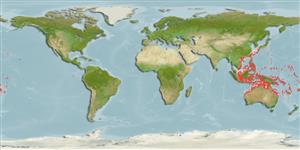分类 / Names
俗名 | 同种异名 | Catalog of Fishes(属, 种) | ITIS | CoL | WoRMS | Cloffa
Teleostei >
Eupercaria/misc (Various families in series Eupercaria) >
Lethrinidae (Emperors or scavengers) > Monotaxinae
Etymology: Gymnocranius: Greek, gymnos = naked + Greek, kranion = skull (Ref. 45335).
More on author: Günther.
Environment: milieu / climate zone / depth range / distribution range
生态学
海洋 礁区鱼类; 非迁移的; 深度上下限 15 - 50 m (Ref. 2295). 熱帶; 35°N - 28°S, 105°E - 170°W
Western Pacific: including southern Japan, South China Sea, Australia, Coral Sea, New Caledonia, and Tonga. Recently reported from Norfolk Island (Ref. 8881).
西太平洋: 包括日本南部,南中國海,澳洲,珊瑚海,新加勒多尼亞與東加。 最近記錄自諾福克島。 (參考文獻 8881)
大小 / 重量 / 年龄
Maturity: Lm ? range ? - ? cm
Max length : 45.0 cm TL 雄鱼/尚未辨别雌雄; (Ref. 2295); common length : 35.0 cm TL 雄鱼/尚未辨别雌雄; (Ref. 2295)
背棘 (总数): 10; 背的软条 (总数): 9-10; 臀棘 3; 臀鳍软条: 9 - 10.
眼是相当大的, 它的下缘在相当上面距离一条线从吻尖到尾叉中央。 尾鳍是适度分叉而且具有钝的顶端。 整体的色彩是银白色到浅灰色的。 背部的鳞片与侧边有一个小的褐色基部的斑点。 突出的黑色斑块是分散的主要在前半部的身体。 一条非常模糊的横带有时候有对颊部的下面边缘的眼睛下面。 鳍有时是清澈的到淡红的,尾鳍暗色的红褐色的。 模糊的斑点可能是显着的在背鳍、尾鳍与臀鳍上。
Occurs over sand and rubble areas adjacent to rock and coral reefs in lagoons and outer slopes (Ref. 9775, 90102). Feeds on bottom-dwelling gastropods. Also caught with bottom longlines and handlines (Ref. 9775). Marketed fresh.
生活在沙子与碎石区邻近岩石与珊瑚礁之上。 吃底栖的腹足动物。 也用底部延绳钓与手执的钓丝捕获。 (参考文献 9775) 在市场上销售生鲜地了。
Life cycle and mating behavior
成熟度 | 繁殖 | 产卵场 | 卵 | 孕卵数 | 仔鱼
西太平洋: 包括日本南部,南中國海,澳洲,珊瑚海,新加勒多尼亞與東加。 最近記錄自諾福克島。 (參考文獻 8881)
Carpenter, K.E. and G.R. Allen, 1989. FAO Species Catalogue. Vol. 9. Emperor fishes and large-eye breams of the world (family Lethrinidae). An annotated and illustrated catalogue of lethrinid species known to date. FAO Fish. Synop. 125(9):118 p. Rome: FAO. (Ref. 2295)
人类利用
渔业: 低经济
更多信息
俗名同种异名新陈代谢捕食者生态毒物学繁殖成熟度产卵场产卵群集孕卵数卵卵的发育
参考文献养殖养殖信息品种遗传学Electrophoreses遗传率疾病加工NutrientsMass conversion
工具
特别资料
下载 XML
网络资源
Estimates based on models
Preferred temperature (Ref.
123201): 24.3 - 28.9, mean 27.6 °C (based on 408 cells).
Phylogenetic diversity index (Ref.
82804): PD
50 = 0.5010 [Uniqueness, from 0.5 = low to 2.0 = high].
Bayesian length-weight: a=0.01905 (0.01079 - 0.03365), b=2.97 (2.82 - 3.12), in cm total length, based on LWR estimates for this species & (Sub)family-body (Ref.
93245).
营养阶层 (Ref.
69278): 3.8 ±0.0 se; based on diet studies.
Generation time: 5.0 ( na - na) years. Estimated as median ln(3)/K based on 2
growth studies.
回复力 (Ref.
120179): 中等的, 族群倍增时间最少 1.4 - 4.4年 (K=0.22-0.24).
Fishing Vulnerability (Ref.
59153): Moderate vulnerability (40 of 100).
Nutrients (Ref.
124155): Calcium = 34.4 [17.3, 63.5] mg/100g; Iron = 0.479 [0.264, 0.793] mg/100g; Protein = 19.6 [17.6, 21.6] %; Omega3 = 0.127 [0.074, 0.185] g/100g; Selenium = 32.5 [19.8, 56.2] μg/100g; VitaminA = 75.8 [23.9, 221.7] μg/100g; Zinc = 1.08 [0.78, 1.48] mg/100g (wet weight);
